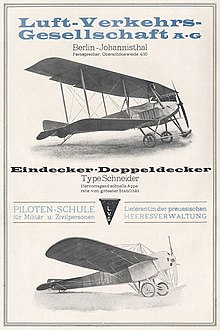Aircraft
Own designs

- LVG B.I - reconnaissance and later trainer aircraft
- LVG B.II - reconnaissance and later trainer aircraft
- LVG B.III - trainer aircraft
- LVG C.I - first tandem-seated aircraft with observer-manned machine gun
- LVG C.II - reconnaissance aircraft
- LVG C.IV - reconnaissance aircraft
- LVG C.V - reconnaissance aircraft
- LVG C.VI - more than 1,000 aircraft of this type were produced
- LVG C.VIII - prototype only
- LVG C.IX - not finished
- LVG D 10
- LVG D.II - prototype only
- LVG D.III - prototype only
- LVG D.IV - prototype only
- LVG D.V - prototype only
- LVG D.VI - prototype only
- LVG E.I - experimental aircraft with two machine guns
- LVG G.I - bomber aircraft
- LVG G.II - triplane
- LVG G.III - triplane bomber designed by Schütte-Lanz but built by LVG, the Schütte-Lanz G.V